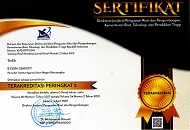USING OF READING, ENCODING, ANNOTATING, AND PONDERING (REAP) TECHNIQUE TO IMPROVE STUDENTS’ READING COMPREHENSION (A Classroom Action Research at Eighth Grade Students in MTSN 1 Kota Bengkulu in Academic years 2016)
Abstract
Abstract
The researcher found the problem at MTSN 1 in the city of Bengkulu at grade VIII I that students got difficulty in comprehending reading texts, and in understanding meanings of words in paragraphs, and teachers techniques made the students bored. Therefore, the purpose of the research is to improve students’ reading comprehension through REAP techniques. The subject of the research is the students of grade VIII I consisting of 27 students, 14 female students and 13 male students. The instruments of the research are reading tets, observation sheetteacher and the students, interview guide and that for documentary study. The results of the research show that the REAP teachniques are effective in improving the students’ reading comprehension. The students got involved directly and were able to cooperate with their peers during the teaching-learning process. The research was conducted in two cycles an the test was administered at the end of each cycle. From the average mean scores, it could be seen that there was improvement of the the students’ reading ability. In cycle I, the mean score was 70.5 and in cycle 2, it was 78.7,and at the Post assessment, it was 82.2. It means that the students’ mean scores has reached the research target. Thus, it can be concluded that REAPtechniques can improve the students’ readng comprehension.
Kata Kunci: REAP (Reading, Encoding, Annotating, and Pondering) technique, Students’ reading comprehension
Keywords
Full Text:
Download PDFReferences
REFERENCES
Fauziyah, Yahya. 2014. The Effectiveness of Using Reading, Encoding, Annotating and Pondering (REAP) Technique Towards Students’ Reading Skill of Descriptive Text (A Quasi-Experimental Study at the Seventh Grade of MTs Salafiyah) Unpublished Thesis, UIN Syarif Hidayatullah, Jakarta.
Marantika, Putri. “The R.E.A.P Technique For Teaching Reading a Narrative Text to Junior High School Students”, Journal of English Language teaching, , Vol. 1 No. 2, September 2013, Series A P. 72.
Manzo, Anthony, Manzo Ula, and Albee, Julie Jackson. 2002. REAP: Improving reading, writing, and thinking in the wired classroom. Journal of Adolescent & Adult Literacy; Sep2002, Vol. 46 Issue 1, p42. Retrieved on 17 February 2015, from www.jstor.org/stable/40017504.
Martono, Nanang. 2012. Metode Penelitian Kuantitatif. Jakarta: Rajawali Press.
Napitupulu, Helentina, Merlina. 2012.The Effect of Teaching Strategies and Cognitive Style on Reading Comprehension. English Applied Lingustics, Post Graduate. Unpublished Thesis.
Nunan David. 1995. Language Teaching Methodology. British :Redwood Books.
Nunan David. 1989. Understanding Language Classroom. New York: Great Britain.
Nuttall Christine. 1996. Teaching Reading Skills in a foreign language. Britain: The Bath Press.
Sam’s, Hartiny, Rosma. 2010. Model PenelitianTindakan Kelas. Yogyakarta: Teras.
Susanti Rini. 2012. Teaching Reading by Combining Reap (Reading, Encoding, Annotating, Pondering) Technique and Exit Slips Technique at Senior High School. Unpublished Thesis, STKIP PGRI Sumatera Barat.
Tibebu Tiruneh, Dawit” The Effect of Explicit Reading Strategy Instruction on Reading Comprehension of Upper Primary Grade Students” (International journal: 2014 V 6, N 3).
Ur Penny . 1996. A Course in Language Teaching. Australia: Cambridge University.
Ur Penny. 1997. A Course in Language Teaching. Australia: Cambridge University.
Weir Cyril. 1993. Understanding and Developing Language Test. Europe: Prentice Hall Europe.
DOI: http://dx.doi.org/10.31958/jt.v19i2.460
Refbacks
- There are currently no refbacks.
Copyright (c) 2016 Fera Zasrianita

This work is licensed under a Creative Commons Attribution-NonCommercial-NoDerivatives 4.0 International License.
TA'DIB with registered number e-ISSN: 2580-2771, p-ISSN: 1410-8208 have been indexed on:

Journal Ta'dib distribute under Lisensi Creative Commons Atribusi-NonKomersial 4.0 Internasional.
Contact us: Ta'dib; Address: FTIK, Universitas Islam Negeri Mahmud Yunus Batusangkar; Jl. Sudirman No. 137 Lima Kaum Batusangkar, Tanah Datar, Sumatera Barat, Indonesia. Email: takdib@uinmybatusangkar.ac.id

























